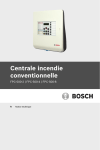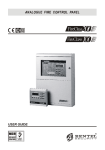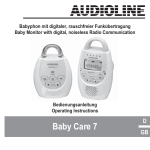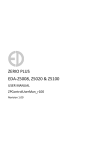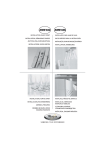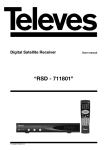Download Operation Guide - Bosch Security Systems
Transcript
Conventional Fire Panel FPC-500-2 | FPC-500-4 | FPC-500-8 en Operation Guide Conventional Fire Panel Table of Contents | en 3 Table of Contents 1 Safety Instructions 4 2 Brief Overview 5 3 System Overview 6 3.1 Functionality 6 3.2 Display on Central Unit 6 3.3 The LCD Display 7 3.4 Operating Levels 9 3.5 Menu Structure 10 3.5.1 Shortcuts in Operating Level 1 11 3.5.2 Shortcuts in Operating Level 2 11 3.5.3 Shortcuts in Test Menu of Operating Level 2 12 4 Operation 13 4.1 Operating Level 1 13 4.1.1 Actions 13 4.1.2 Menu 15 4.2 Operating Level 2 18 4.2.1 Actions 19 4.2.2 Test/Disablements Menu 20 4.2.3 Menu 24 5 Troubleshooting 27 6 Maintenance 28 A Appendix 29 A.1 Event Memory 29 A.2 Test Memory Messages 30 Index 31 Bosch Sicherheitssysteme GmbH Operation Guide F.01U.172.982 | 5.0 | 2012.04 4 1 en | Safety Instructions Conventional Fire Panel Safety Instructions CAUTION! Only silence alarms once you have ensured that no persons will be endangered by the deactivation of the sirens. CAUTION! Only switch zones to test mode for brief periods of time. Zones in test mode will not trigger an alarm in the event of a fire. CAUTION! Only deactivate zones for brief periods of time. Deactivated zones will not trigger an alarm in the event of a fire. NOTICE! Your fire detection system and all connected components must be subjected to professional maintenance on a regular basis. Observe all local regulations. DANGER! The housing must only be opened by a specialist. There is a danger of electric shock. CAUTION! Do not deactivate the power supply to the fire detection system. After using up the emergency power supply, the fire detection system will be unable to trigger a fire alarm. NOTICE! If you encounter any irregularities during the operation of your fire detection system (fault messages etc.), contact your specialist immediately. F.01U.172.982 | 5.0 | 2012.04 Operation Guide Bosch Sicherheitssysteme GmbH Conventional Fire Panel 2 Brief Overview | en 5 Brief Overview 1 ALARM 2 3 4 Pre-Alarm 5 6 7 8 2 1 2 Fault System Fault 3 Earth Fault 4 Power Fault EVAC NAC Fault / Disabled 5 Notification Appliance Silent Day Mode i A CK Disable 6 7 ESC Test RESET Power 1 4 1 LED display 2 LCD display with zone numbers 3 Zone keys and zone status LEDs 4 Operating panel Bosch Sicherheitssysteme GmbH Operation Guide 8 3 F.01U.172.982 | 5.0 | 2012.04 6 en | System Overview Conventional Fire Panel 3 System Overview 3.1 Functionality The FPC-500 Fire Panel is the main component of your fire detection system. As the central control unit, the FPC-500 manages all information received from the detectors. Depending on the relevant programming, the FPC-500 Fire Panel relays all alarms to the connected notification appliances and outputs. As the user, you can control the behavior of the entire system. You can silence and reset triggered alarms, change alarm triggering delays (day/night mode), test zones and much more. However, the system can only be programmed by persons with advanced user rights. Therefore, any faults etc. must be reported to your on-site specialist. 3.2 Display on Central Unit Your fire panel features a number of LEDs to indicate operating states and faults. Zone LED Meaning Red Constant The relevant zone is in alarm state. Red Flashing, 0.5 Hz The zone has triggered a pre-alarm. Yellow Flashing, 0.5 Hz The zone has a fault. Yellow Constant The zone is deactivated. Yellow Flashing, 2 Hz The zone is in test mode. Notification appliance Meaning fault/disabled – LED Yellow Constant Notification appliances are disabled. Yellow Flashing, 2 Hz There is a fault in the notification appliance. F.01U.172.982 | 5.0 | 2012.04 Operation Guide Bosch Sicherheitssysteme GmbH Conventional Fire Panel System Overview | en 7 LED Meaning Fire At least one zone has triggered a fire alarm. The LEDs of the triggering zones are illuminated red. Pre-Alarm At least one zone has triggered a pre-alarm. The LED flashes every 2 seconds. The LEDs of the zones that have triggered the pre-alarm flash red. Fault At least one component in the system has a fault. System fault The system is or was not working correctly. Perform a reset to check whether the fault persists. Ground fault The fire detection system continuously checks for an earth connection (a panel wire is connected to the ground). There is a ground fault. Power supply fault There is a fault in the power supply (battery or power supply unit). NAC fault/disabled There is a fault on the notification appliance lines or at least one notification appliance line is switched off. Notification The notification appliances have been silenced. Appliance Silent Day mode The system is in daytime mode. Zones that are programmed as alarm verification trigger an alarm. You are prompted by the panel to verify the alarm. Disablements At least one system component is disabled. (Zone, notification appliance, relay) Test At least one zone is in test mode. The relevant zone LEDs flash at 2 Hz. Power Lit continuously in green when the system is supplied with power. 3.3 The LCD Display 1 Bosch Sicherheitssysteme GmbH 2 3 4 Operation Guide 5 6 7 8 F.01U.172.982 | 5.0 | 2012.04 8 en | System Overview Conventional Fire Panel Normal, Night Mode 1 2 3 4 5 6 7 8 Normal 01/01/11 01:00 Normal display with current time and date. Normal, Daytime Mode 1 2 3 4 5 6 7 8 Normal Day 01/01/11 01:00 Normal display with current time and date in daytime mode. Fault displays 1 2 3 4 5 6 7 8 |F|D| | |T| | NAC # Open Used to display faults. Zones where there is a fault are flagged with corresponding letters. In addition, fault messages are displayed in plain text in the bottom line. If there is more than one fault, the display changes every 1.5 seconds. The following abbreviations are used: – F = Fault (short-circuit/open/creeping short-circuit/ creeping open) – D =Disabled – T = Test Pre-Alarms 1 2 3 4 5 6 7 8 |P|P| | |P| | PreAlarms: 3 Display of pre-alarms. Zones that have triggered a pre-alarm are flagged In addition, the total number of pre-alarms is displayed in the bottom line. The pre-alarms are then displayed one after another in order of their appearance. F.01U.172.982 | 5.0 | 2012.04 Operation Guide Bosch Sicherheitssysteme GmbH Conventional Fire Panel System Overview | en 9 Alarms 1 2 3 4 5 6 7 8 |?| | | | | | Fire Alarms: 1 Display of alarms. Zones that have triggered an alarm are flagged. In addition, the total number of alarms is displayed in the bottom line, along with the sequence of the triggered alarms. 3.4 Operating Levels This fire panel has three operating levels. You can only perform certain actions on certain operating levels. Level 1 Level 2 – Display information – Read out event memory – Display faults and deactivations – Perform display test – Change language and time/date – Switch key tones on/off – Put zones in test mode and take zones out of test mode – Switch off/on zones, notification appliances, relays and – Trigger evacuations transistor outputs Level 3 – Reset panel – Switch between day/night mode – All actions of level 1 – All settings for installing and programming the system. Code inputs are necessary for accessing operating levels 2 and 3. Operating level 2 can be accessed using the optional key or an input with the appropriate configuration. Bosch Sicherheitssysteme GmbH Operation Guide F.01U.172.982 | 5.0 | 2012.04 10 en | System Overview 3.5 Conventional Fire Panel Menu Structure Submenu 1 2 3 Menu operating level 1 and 2 i 1 2 Current Events History 1 Faults - - 2 Disablements - - 3 Test - - 4 PreAlarm - - 1 Event History - - 2 Test History - - 3 Alarm Counter - - - - 4 System Info 1 SW Release - - 2 Operation Days - - Menu operating level 2 – code required i 5 View Config - - - - 6 System Config 1 Date/Time - - 2 Keypad Tone 1 On 2 Off 1 1-A - L 2 2-M - Z 3 Language Test menu 1 Test MMI - - - - 2 Test Zones - - - - 3 Dis/Enable 1 Zones - - 2 NAC ACK #=YES ESC=No 3 Relays ACK #=YES ESC=No 4 All ACK #=YES ESC=No F.01U.172.982 | 5.0 | 2012.04 Operation Guide Bosch Sicherheitssysteme GmbH Conventional Fire Panel 3.5.1 System Overview | en 11 Shortcuts in Operating Level 1 Deactivate internal buzzer (Page 14) Perform display test (Page 14) 1 Display zone status (Page 14) 1 Check current faults (Page 15) Display current disablements (Page 15) Display current tests (Page 16) Check current pre-alarms (Page 16) Check event history (Page 16) Display test history (Page 16) Check alarm counter (Page 17) Display software version (Page 17) Check operating days (Page 17) 3.5.2 ... 8 i 1 1 i 1 2 i 1 3 i 1 4 i 2 1 i 2 2 i 3 i 4 1 i 4 2 Shortcuts in Operating Level 2 Call up operating level 2 (Page 18) +CODE Exit operating level 2 (Page 18) ACK Switch between day/night mode (Page 19) +CODE Perform reset (Page 19) RESET ACK +CODE Evacuation (Page 19) ACK EVAC +CODE Silence alarm devices (Page 20) +CODE Display configuration (Page 25) Set date/time (Page 25) Switch key tones on/off (Page 25) Select language (Page 26) Bosch Sicherheitssysteme GmbH Operation Guide i 5 i 6 1 i 6 2 i 6 3 F.01U.172.982 | 5.0 | 2012.04 12 en | System Overview 3.5.3 Conventional Fire Panel Shortcuts in Test Menu of Operating Level 2 Call up test menu (Page 21) +CODE Test MMI 1 Zones in test mode (Page 21) 2 Disable/enable zones (Page 22) Disable/enable notification appliance Disable/enable relay (Page 23) Disable/enable all (Page 24) F.01U.172.982 | 5.0 | 2012.04 Operation Guide 1 ... 8 ACK 3 1 3 2 3 3 ACK 3 4 ACK 1 ... 8 ACK ACK Bosch Sicherheitssysteme GmbH Conventional Fire Panel 4 Operation | en 13 Operation You have different options for navigating in the menu of the fire panel. Using autoscrolling The menus scroll automatically every 2.5 seconds to the next menu item. If you would like to select the menu item currently ACK shown, simply confirm with the ACK key. Navigating with the zone keys 1 ... 8 In the menu, each menu item has a number from 1 to 8 preceding it. Use the zone keys to select the desired menu item in the menu. The desired menu item does not have to be shown in the display. Navigating with the arrow keys Use the arrow keys to navigate in the menu. i Using the arrow keys stops autoscrolling in the menus. Confirm your selection in the menu with the ACK key. ACK Exiting submenus ESC RESET In the menu and in the submenus, you can jump to a higher level or cancel the setting using the RESET (ESC) key. Hold the RESET (ESC) key down for 2 seconds to jump to the uppermost level. 4.1 Operating Level 1 4.1.1 Actions The following actions can be performed in level 1: Bosch Sicherheitssysteme GmbH Operation Guide F.01U.172.982 | 5.0 | 2012.04 14 en | Operation Conventional Fire Panel Alarm verification (if programmed) NOTICE! This procedure only applies to zones that are programmed as alarm verification. Note that the delay settings are only effective in day mode. In night mode, the alarm is triggered immediately. A zone programmed as alarm verification triggers an alarm, which you must confirm manually. Press the ACK button within the programmed confirmation time. ACK The programmed verification time begins. Check the area of the zone triggering the fire alarm to see if there is really any fire. If you have discovered a real fire, use either a manual call point or the EVAC button to trigger the alarm. In the event of a false alarm, you can reset the panel within ESC the programmed verification time using the RESET (ESC) RESET button. NOTICE! Once the confirmation time and verification time have elapsed an alarm is triggered automatically. Switching off the internal buzzer Press the "Buzzer off" key. The buzzer is now deactivated. Perform display test 1 Press the "Test" key and then zone key 1. All LEDs light up for three seconds and the buzzer sounds. Checking the zone status 1 ... 8 To check the status of a zone, press the relevant zone key (1 to 8). The LCD display shows the status of the selected zone. F.01U.172.982 | 5.0 | 2012.04 Operation Guide Bosch Sicherheitssysteme GmbH Conventional Fire Panel 4.1.2 Operation | en 15 Menu The following options are available in the menu: – 1-Current Events – – 1-Faults – 2-Disablements – 3-Test – 4-PreAlarm 2-History – 1-Event History – 2-Test History – 3-Alarm Counter – 4-System Info – 1-SW Release – 2-Operation Days Opening the menu Press the "Menu" key. i You are now in the menu. Exiting the menu/submenus Press the "Reset" key. You have now moved up one level. RESET Displaying faults Displays a list of all current faults with the corresponding time stamps. i 1 1 Press the "Menu" key and then zone key 1. This takes you to the Current Events submenu. Press zone key 1. The LCD shows the current fault messages. Displaying disablements Displays a list of all current disablements with the corresponding time stamps. Bosch Sicherheitssysteme GmbH Operation Guide F.01U.172.982 | 5.0 | 2012.04 16 en | Operation i 1 Conventional Fire Panel Press the "Menu" key and then zone key 1. This takes you to the Current Events submenu. Press zone key 2. 2 The LCD display shows the current disablements. Displaying zones in test mode Shows a list of all current zones in test mode, including the time stamp. i 1 Press the "Menu" key and then zone key 1. This takes you to the Current Events submenu. Press zone key 3. 3 The LCD display shows the current tests. Displaying pre-alarms Displays a list of all current pre-alarms with the corresponding time stamps. i 1 Press the "Menu" key and then zone key 1. This takes you to the Current Events submenu. Press zone key 4. 4 The LCD display shows the current pre-alarms. Displaying the event log Displays a list of all events with the corresponding time stamps. A list of events can be found in Section A.1 Event Memory, page 29 i 1 2 Press the "Menu" key and then zone key 2. This takes you to the History submenu. Press zone key 1. The messages in the event memory are displayed. You can use the arrow keys to switch between the individual entries. If you press and hold an arrow key, the display moves 10 steps in the corresponding direction. A description of the displayed events can be found on Page 29 ff. Displaying the test log Call up the menu; see Section Opening the menu, page 15 F.01U.172.982 | 5.0 | 2012.04 Operation Guide Bosch Sicherheitssysteme GmbH Conventional Fire Panel i 2 Operation | en 17 Press the "Menu" key and then zone key 2. This takes you to the History submenu. Press zone key 2. 2 The messages in the test memory are displayed. You can use the arrow keys to switch between the individual entries. If you press and hold an arrow key, the display moves 10 steps in the corresponding direction. A description of the displayed events can be found on Page 30. If the test log should be disabled, "No Entry" appears on the LCD. Displaying alarm counters Call up the menu; see Section Opening the menu, page 15 i 3 Press the "Menu" key and then zone key 3. The LCD shows the number of alarms since the initial start-up. The alarm counter cannot be deleted. It only counts alarms triggered by zones up to 999. It does not count pre-alarms or evacuations triggered manually via the panel or the inputs. Displaying SW Release Call up the menu; see Page 15. i 4 Press the "Menu" key and then zone key 4. This takes you to the System Info submenu. Press zone key 1. 1 The software version is displayed. Displaying the operation days Call up the menu; see Section Opening the menu, page 15 i 2 4 Press the "Menu" key and then zone key 4. This takes you to the System Info submenu. Press zone key 2. The number of operation days is displayed Bosch Sicherheitssysteme GmbH Operation Guide F.01U.172.982 | 5.0 | 2012.04 18 en | Operation 4.2 Conventional Fire Panel Operating Level 2 To be able to perform the actions in operating level 2, you will need a code you can enter with the zone keys. Calling up operating level 2 via a code Press the "Code input" key. You will be prompted to enter a code. Enter the code with zone keys 1 to 8. The preset code is 1234. CODE The code can be changed in operating level 3. If you are in level 2, a small 2 is displayed in the top right corner of the display. Calling up operating level 2 via a key (optional) Use the key to open operating level 2. Leave the key turned in the lock while you are working in operating level 2. Automatic exit of level 2 If you are in level 2 and a key has not been pressed for 10 minutes, the system will exit level 2 automatically. This also applies if you are using a key. One minute before exiting level 2, a pulse tone from the internal buzzer indicates the passing time, while a countdown is shown in the LCD display. Exiting operating level 2 If you are in operating level 2, proceed as follows. Press the "Code input" key. – ACK Press the ACK key. You exit operating level 2. RESET – Press the "Reset" key. You remain in operating level 2. If you accessed operating level 2 using the optional key, turn the key back and remove it from the lock to exit operating level 2. F.01U.172.982 | 5.0 | 2012.04 Operation Guide Bosch Sicherheitssysteme GmbH Conventional Fire Panel 4.2.1 Operation | en 19 Actions Switching between day and night mode Press the "Day/night mode" key. The "Day mode" LED is illuminated in day mode and deactivated in night mode. The LCD shows Normal in night mode and Normal Day in day mode. In day mode, delay times are activated in zones that are programmed as alarm verification. Performing a reset Press the "Reset" key. RESET – ACK Press the ACK key. The fire panel performs a reset if it is not in a normal RESET state. – Press the "Reset" key. No reset is performed. Trigger evacuation, test alarm NOTICE! Only trigger an evacuation if you want to trigger a test alarm. You can only trigger a test alarm when the fire panel is in the normal state. NOTICE! As standard, the EVAC button only activates the notification appliances. CAUTION! If you have discovered a real fire, use a manual call point to trigger the alarm. Bosch Sicherheitssysteme GmbH Operation Guide F.01U.172.982 | 5.0 | 2012.04 20 en | Operation Conventional Fire Panel Press the "Evacuation" key. EVAC – ACK Press the ACK key. The fire panel activates all notification appliances and RESET relays as programmed. – Press the "Reset" key. No evacuation is triggered. EVAC button functions The EVAC button has various functions, depending on the status of the fire panel: – Panel in normal state You can trigger a test alarm using the EVAC button. – Panel in alarm state If you have silenced the notification appliances, you can reactivate them using the EVAC button. – Panel in alarm verification, dual-zone dependency, or dualdetector dependency state The delay for the alarm notification appliances is ended. The notification appliances are triggered immediately. Silencing notification appliances NOTICE! Only silence an alarm once you have made sure that there is not actually a fire. You can reactivate silenced alarm devices using the EVAC button. Press the "Silence notification appliance" key. The fire panel deactivates all notification appliances and relays as programmed. A new alarm reactivates the notification appliances and relays, if programmed. 4.2.2 Test/Disablements Menu The following options are available in the test menu: – 1-Test MMI – 2-Test Zones F.01U.172.982 | 5.0 | 2012.04 Operation Guide Bosch Sicherheitssysteme GmbH Conventional Fire Panel – Operation | en 21 3-Dis/Enable – 1-Zones – 2-NAC – 3-Relays – 4-All Calling up the test menu Press the "Test" key. You are now in the test menu. Performing an MMI test See Section Perform display test, page 14. Switching zones to test mode CAUTION! Only switch zones to test mode for brief periods of time. Zones in test mode will not trigger an alarm in the event of a fire. 2 1 ... 8 Press the "Test" key and then zone key 2. This takes you to the Test Zones submenu Select the zones to be set to test mode. To do this, press the relevant zone keys 1 to 8. A code appears below the selected zone(s) in the LCD. Multiple zones can be switched to test mode at the same time. Confirm your selection with the ACK key. ACK The "Test" LED and the LEDs for the selected zones are illuminated yellow. NOTICE! Only zones that are in a normal state can be set to test mode. Selecting a zone again removes it from test mode. Bosch Sicherheitssysteme GmbH Operation Guide F.01U.172.982 | 5.0 | 2012.04 22 en | Operation Conventional Fire Panel Testing the zones NOTICE! The fire panel features a test memory, which stores all the panel's testing procedures. All memory entries are assigned a date and time stamp and cannot be deleted. The test memory can be called in operating levels 1 and 2. Use a manufacturer-approved test device to test each individual detector in the zones currently in test mode. In each case, use the test device to trigger an alarm. NOTICE! The fire panel test function is designed for operation by a single person: The fire panel automatically resets the alarm 15 seconds after an alarm is triggered in a zone in test mode. This is followed by the set time for disabling the zone and the stabilization time for the detectors. The next detector can then be tested. Removing individual zones from test mode Access the Zones menu in test mode as described above. Use the zone keys to cancel test mode for the relevant zones. The code below the selected zone in the LCD disappears. Disabling zones CAUTION! Only disable zones for brief periods of time. Disabled zones will not trigger an alarm in the event of a fire. 3 1 Press the "Test" key and then zone key 3. This takes you to the Dis/Enable submenu Press zone key 1. This takes you to the Zones submenu F.01U.172.982 | 5.0 | 2012.04 Operation Guide Bosch Sicherheitssysteme GmbH Conventional Fire Panel 1 ... Operation | en 23 Select the zones to be disabled. To do so, press the relevant 8 zone keys (1 to 8). A code appears below the selected zone(s) in the LCD. Confirm your selection with the ACK key. The "Disable" LED and the LEDs for the selected zones are ACK illuminated yellow. Re-enabling zones Go to the Disable Zones menu as described above. Use the zone keys to cancel existing disablements. The code below the selected zone in the LCD disappears. Disabling notification appliances 3 This takes you to the Dis/Enable submenu Press zone key 2. 2 ACK Press the "Test" key and then zone key 3. You are prompted to confirm the disablement. – Press the ACK key. – Press the "Reset" key. The notification appliances are now disabled. RESET The notification appliances are not disabled. When you disable the notification appliances, a message confirming the disablement appears on the LCD after exiting the menu. Re-enabling notification appliances Go to the Disable NAC menu as described above. You are prompted to confirm the re-enablement. Press the ACK key. The notification appliances are re-enabled. Disabling relays 3 Press the "Test" key and then zone key 3. This takes you to the Dis/Enable submenu Bosch Sicherheitssysteme GmbH Operation Guide F.01U.172.982 | 5.0 | 2012.04 24 en | Operation Press zone key 3. 3 You are prompted to confirm the disablement. – ACK Conventional Fire Panel Press the ACK key. The relays are now disabled. RESET – Press the "Reset" key. The relays are not disabled. When you disable the relays, a message confirming the disablement appears on the LCD after exiting the menu. Re-enabling relays Go to the Disable Relays menu as described above. You are prompted to confirm the re-enablement. Press the ACK key. The relays are re-enabled. Disabling/enabling All (zones, relays, notification appliances) 3 4 Press the "Test" key and then zone key 3. This takes you to the Dis/Enable submenu. Press zone key 4. This takes you to the All submenu. Upon confirmation via the ACK key, all zones, relays and ACK notification appliances will be disabled/re-enabled. You can use the "Enable All" function if only one relay, one zone or one notification appliance has been disabled. 4.2.3 Menu In addition to the functions in level 1, the menu provides the following options: – 5-View Config – 6-System Config – 1-Date/Time – 2-Keypad Tone – 3-Language - 1- A–L - 2- M–Z F.01U.172.982 | 5.0 | 2012.04 Operation Guide Bosch Sicherheitssysteme GmbH Conventional Fire Panel Operation | en 25 Displaying the configuration i 5 Press the "Menu" key and then zone key 5. This takes you to the View Config submenu. The set configuration is automatically shown in the LCD i display. The individual settings are displayed successively at 2.5-second intervals. If you use the arrow keys to navigate manually through the configuration display, the automatic process is cancelled. Press the "Reset" key. You exit the configuration display. RESET Setting the date/time i 6 Press the "Menu" key and then zone key 6. This takes you to the System Config submenu. Press zone key 1. 1 You can now set the date and time. The current entry is displayed. i Use the arrow keys to change the flashing value. To save the currently displayed value, press the ACK key. ACK Repeat the steps to set the month, year, hour and minute. Setting the buzzer beep i 6 This takes you to the System Config submenu. Press zone key 2. 2 1 Press the "Menu" key and then zone key 6. You can now set the buzzer beep. ... 2 Press the zone keys to set the buzzer beeps: – 1=On (default setting) – 2 Off Bosch Sicherheitssysteme GmbH Operation Guide F.01U.172.982 | 5.0 | 2012.04 26 en | Operation Conventional Fire Panel Setting the language i 6 This takes you to the Language submenu. Press zone key 1 to select a language in the A - L range. 1 ... 8 Use the zone keys to set the relevant language. – 1 čeština – 2 Deutsch – 3 English – 4 Español – 5 Français – 6 Italiano Press zone key 2 to select a language in the M - Z range. 2 1 This takes you to the System Config submenu. Press zone key 3. 3 1 Press the "Menu" key and then zone key 6. ... 8 Use the zone keys to set the relevant language. – 1 Magyar – 2 Nederlands – 3 Polski – 4 Português – 5 Român – 6 Turkçe NOTICE! If you have selected the incorrect language, you can select the language again when restarting by using a cold start (disconnect power from system). F.01U.172.982 | 5.0 | 2012.04 Operation Guide Bosch Sicherheitssysteme GmbH Conventional Fire Panel 5 Troubleshooting | en 27 Troubleshooting "Fault" LED lit Check the fault message memory Perform a system reset. If you cannot resolve the fault, please contact your specialist. "System fault" LED lit The system is or was not working correctly. In the event of a system fault, the system performs an automatic reset. The fault display is retained for safety reasons. Perform a reset. If this does not resolve the fault, please contact your specialist immediately. "Ground fault" LED lit There is a fault in the cabling (one line in the panel is connected to earth). Perform a system reset. If you cannot resolve the fault, please contact your specialist immediately. "Power supply fault" LED lit There is a fault with the power supply (mains or battery). Perform a system reset. If you cannot resolve the fault, please contact your specialist immediately. "Notification appliance fault/disabled" LED flashing There is a fault with the notification appliances. Perform a system reset. If you cannot resolve the fault, please contact your specialist immediately. Bosch Sicherheitssysteme GmbH Operation Guide F.01U.172.982 | 5.0 | 2012.04 28 6 en | Maintenance Conventional Fire Panel Maintenance Keep a log book that includes the following data as a minimum: – Information on the monitored object – Contact details of the maintenance company – Events Record all events, such as alarms, faults and services, in this log book. Ensure that an inspection is carried out on your fire detection system four times a year at roughly regular intervals. Ensure that the following function checks are carried out during the inspection: – Trigger an automatic detector for each zone to check the transmission lines and notification appliances – Test the condition of the batteries and the function of the – Check the log book power supply unit Record the inspection and the results in the log book. Carry out the following additional checks at least once a year: – Check all elements of the fire panel – Trigger all detectors that can be tested without being damaged – Visually check all cabling and elements NOTICE! – Have maintenance and inspection work carried out regularly by trained, qualified personnel – Please observe the appropriate requirements stipulated by the local authorities (e.g. fire service) NOTICE! Replace the batteries regularly. Please observe the appropriate requirements stipulated by the local authorities etc. F.01U.172.982 | 5.0 | 2012.04 Operation Guide Bosch Sicherheitssysteme GmbH Conventional Fire Panel | en A Appendix A.1 Event Memory Message Drill/Evacuate Zone # Alarm Zone # PreAlarm Zone # Open Zone # Short Zone # Normal Meaning A manual alarm has been triggered on the panel. Zone # has triggered an alarm. Zone # has triggered a pre-alarm. Zone # is interrupted. Zone # has a short-circuit. Zone # is in the normal state. (Fault or alarm Zone # Disabled Zone # Enabled Input # Open Input # Short Input # Normal Aux Power Short Aux Power Normal NAC # Open NAC # Short NAC # Normal eliminated) Zone # is disabled. Zone # was enabled. Input # interrupted. Input # short-circuit. Input # normal. Short-circuit in the AUX power supply Fault in the AUX power supply rectified. Notification appliance #, line interrupted Notification appliance #, short-circuit on line. Notification appliance # normal. (Fault was NAC Enabled NAC Disabled Relays Enabled Relays Disabled Battery Fault Battery Restore Mains Fault Mains Restore Ext PS Fault Ext PS Normal Ext BATT Fault Ext BATT Normal Sys Load Fault eliminated) Notification appliances re-enabled. Notification appliances disabled. Relays re-enabled. Relays disabled. Fault in the battery power supply. Battery power supply was restored. Fault in the 230 V power supply. 230 V power supply was restored. Fault in external power supply unit. Fault in external power supply unit resolved. Fault in external battery. Fault in external battery resolved. Current consumption of panel and all connected Sys Load Normal System Fault Panel boot-up Reset Panel peripherals is above 3.5 A. Current consumption is back in permitted range. System fault Panel has been restarted. Panel has been reset. Bosch Sicherheitssysteme GmbH Operation Guide 29 F.01U.172.982 | 5.0 | 2012.04 30 en | Conventional Fire Panel Message Night Mode Day Mode Earth Fault Earth Normal Level # Enter Level # Exit Silenced Unsilenced A.2 Meaning Panel has switched to night mode. Panel has switched to day mode. Grounding fault. Fault in grounding resolved. Operating level # entered. Operating level # exited. An alarm has been silenced. A silenced alarm has been reactivated. Test Memory Messages Message Zone # Start Zone # Test Zone # End F.01U.172.982 | 5.0 | 2012.04 Meaning Zone # set to test mode. Zone # successfully tested. Zone # test mode exited. Operation Guide Bosch Sicherheitssysteme GmbH Conventional Fire Panel Index | en 31 Index A Alarm counter Displaying 17 Alarm devices Silencing 20 Alarm Verification 14 All Disable 24 Event memory Displaying 16 F Fault displays LCD display 8 Faults 15 Display 15 Functionality 6 B L Buzzer Switching off 14 Buzzer beep Setting 25 Language Setting 26 LED 7 Day mode 7 Disablements 7 Fault 7 Fire 7 Ground fault 7 NAC fault 7 Notification appliance silent 7 Power 7 Power supply fault 7 Pre-Alarm 7 System fault 7 Test 7 Zone 6 C Calling up Test menu 21 Configuration Displaying 25 D Date/time Setting 25 Day/night mode Switching 19 Disable All 24 Notification appliances 23 Relays 23 Zones 22 Disablements Display 15 Display 15 Disablements 15 Test log 16 Display test 14 Displaying Alarm counter 17 Event memory 16 Operation days 17 Pre-alarms 16 Software version 17 E M Manual alarm verification 14 Menu Exiting 15 Opening 15 N Navigating Arrow keys 13 Navigation Zone keys 13 Notification appliances Disable 23 O Opening Menu 15 Evacuation 20 Bosch Sicherheitssysteme GmbH Operation Guide F.01U.172.982 | 5.0 | 2012.04 32 en | Index Conventional Fire Panel Operating level 2 Exiting 18 Exiting automatically 18 Opening, with code 18 Opening, with key 18 Operation days Displaying 17 P Performing Reset 19 Pre-alarms Displaying 16 R Relays Disable 23 Reset Performing 19 S Setting Buzzer beep 25 Date/time 25 Language 26 Software version Displaying 17 Submenu Exiting 15 Switching Day/night mode 19 Switching off Buzzer 14 T Test log Display 16 Test menu 20 Calling up 21 Test mode Zones 21 Tests Displaying 16 Z Zones Checking 14 Disable 22 Test mode 21 F.01U.172.982 | 5.0 | 2012.04 Operation Guide Bosch Sicherheitssysteme GmbH Bosch Sicherheitssysteme GmbH Robert-Bosch-Ring 5 85630 Grasbrunn Germany www.boschsecurity.com © Bosch Sicherheitssysteme GmbH, 2012



































